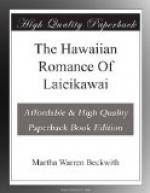1. The most common is used to provide suspense for what is to follow and is printed without the point—aia hoi, literally, “then (or there) indeed,” with the force of our lo! or behold!
2. Another less common form, native to the Hawaiian manner of thought, is the contradiction of a plausible conjecture—aole ka! “not so!”. Both these forms occur in narrative or in dialogue. The four following are found in dialogue alone:
3. Auhea oe? “where are you?” is used to introduce a vigorous address.
4. Auwe! to express surprise (common in ordinary speech), is rare in this story.
5. The expression of surprise, he mea kupapaha, is literally “a strange thing,” like our impersonal “it is strange”
6. The vocable e is used to express strong emotion.
7. Add to these an occasional use, for emphasis, of the belittling question, whose answer, although generally left to be understood, may be given; for example: A heaha la o Haua-i-liki ia Laie-i-ka-wai? he opala paha, “What was Hauailiki to Laieikawai? ‘mere chaff!’”, and the expression of contempt—ka—with which the princess dismisses her wooer]
IV. CONCLUSIONS
1. Much of the material of Hawaiian song and story is traditional within other Polynesian groups.
2. Verse making is practiced as an aristocratic art of high social value in the households of chiefs, one in which both men and women take part.
3. In both prose and poetry, for the purpose of social aggrandizement, the theme is the individual hero exalted through his family connection and his own achievement to the rank of divinity.
4. The action of the story generally consists in a succession of contests in which is tested the hero’s claim to supernatural power. These contests range from mythical encounters in the heavens to the semihistorical rivalries of chiefs.
5. The narrative may take on a high degree of complexity, involving many well-differentiated characters and a well-developed art of conversation, and in some instances, especially in revenge, trickster, or recognition motives, approaching plot tales in our sense of the word.
6. The setting of song or story, both physical and social, is distinctly realized. Stories persist and are repeated in the localities where they are localized. Highly characteristic are stories of rock transformations and of other local configurations, still pointed to as authority for the tale.
7. Different types of hero appear:
(a) The hero may be a human being of high rank and of unusual power either of strength, skill, wit, or craft.
(b) He may be a demigod of supernatural power, half human, half divine.
(c) He may be born in shape of a beast, bird, fish, or other object, with or without the power to take human form or monstrous size.




